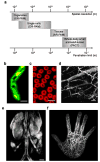A practical guide to photoacoustic tomography in the life sciences
- PMID: 27467726
- PMCID: PMC4980387
- DOI: 10.1038/nmeth.3925
A practical guide to photoacoustic tomography in the life sciences
Abstract
The life sciences can benefit greatly from imaging technologies that connect microscopic discoveries with macroscopic observations. One technology uniquely positioned to provide such benefits is photoacoustic tomography (PAT), a sensitive modality for imaging optical absorption contrast over a range of spatial scales at high speed. In PAT, endogenous contrast reveals a tissue's anatomical, functional, metabolic, and histologic properties, and exogenous contrast provides molecular and cellular specificity. The spatial scale of PAT covers organelles, cells, tissues, organs, and small animals. Consequently, PAT is complementary to other imaging modalities in contrast mechanism, penetration, spatial resolution, and temporal resolution. We review the fundamentals of PAT and provide practical guidelines for matching PAT systems with research needs. We also summarize the most promising biomedical applications of PAT, discuss related challenges, and envision PAT's potential to lead to further breakthroughs.
Conflict of interest statement
L.V.W. has a financial interest in Microphotoacoustics, Inc., which, however, did not support this work. J.Y. declares no competing financial interests.
Figures







References
-
- Bell AG. Upon the production and reproduction of sound by light. American Journal of Science. 1880;20:305–324.
-
- Bowen T. Radiation-induced thermoacoustic imaging. 4,385,634. University of Arizona Foundation; US Patent. 1983
-
- Oraevsky AA, Jacques SL, Tittel FK. In: Laser-Tissue Interaction IV. Jacques SL, Katzir A, editors. Vol. 1882. SPIE; San Jose, CA: 1993. pp. 86–101.
-
- Kruger RA, Liu PY. Photoacoustic Ultrasound - Pulse Production and Detection in 0.5-Percent Liposyn. Med Phys. 1994;21:1179–1184. - PubMed
-
- Kruger RA. Photoacoustic Ultrasound. Med Phys. 1994;21:127–131. - PubMed
Publication types
MeSH terms
Grants and funding
LinkOut - more resources
Full Text Sources
Other Literature Sources

